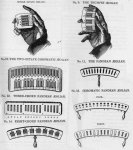The Austrian online Musiklexicon website has some information on Cyrill Demian and his sons.
It says C. Demian arrived in Vienna in 1805.
Quote :
Demian (Damian, Dämian, Dimian), Familie
Klavier- und Orgelmacher, Erfinder des Akkordeons (Harmonika-Instrumente)
Cyrill: * 1774 Silwasch/Siebenbürgen (Silvaș, Satu Mare?/RO, nicht eindeutig identifizierbar), † 1.11.1847 Wien. 1805 reichte er in Wien um ein Privileg oder Meisterrecht ein und erhielt 1810 eine unbeschränkte Befugnis als Klaviermacher. C. D. dürfte zu seiner Zeit einen guten Ruf besessen haben, zählt ihn doch Stephan Edler von Keeß zu den besten Herstellern von Tafelklavieren. Heute ist er als Erfinder des Akkordeons ein Begriff. Die Verleihung des Patentes, zunächst „für die Dauer von zwey Jahren auf die Erfindung eines neuen Instrumentes ‚Accordion‘ genannt, welches die Form eines kleinen Kästchens hat, worin Federn auf Stahlplatten sammt einem Blasebalg angebracht sind, und zwar dergestalt, daß es bequem eingesteckt werden kann, daher Reisenden insbesondere erwünscht seyn muß (Wr. Ztg. 10.7.1829), erfolgte am 23. Mai 1829 für ihn und seine beiden Söhne und wurde am 28.1.1831 um weitere drei Jahre verlängert. Ursprünglich nur aus sechs Tasten bestehend, wurde das Akkordeon bald auf zehn Tasten erweitert, später kamen noch Halbtöne sowie sechs bis zehn Basstöne für die linke Hand hinzu. Bald wurde es so populär, „daß man allenthalben, besonders in den Abendstunden, die accordähnlichen Töne auf den Straßen und Promenaden vernehmen kann. (Wr. Theater-Ztg. 11.10.1834). D. modifizierte auch die Physharmonika. Seine Söhne
Karl Mathias (* 6.7.1807 Wien, † 31.12.1869 Wien) und Guido (* 24.11.1811 Wien, † 20.1.1848 Wien) waren ebenfalls auf musikalischem Gebiet tätig (Karl als Klavierlehrer und Klavierstimmer), wobei aber unklar ist, ob sie selbst Instrumente herstellten. Guido starb als Vize-Feldwebel beim IR Nr. 4 (Hoch- und Deutschmeister).
LITERATUR
MGG 2 (1996), 189; H. Haupt in StMw 24 (1960), 131; Hopfner 1999; Ottner 1977; St. Edler v. Keeß (Hg.), Darstellung des Fabriks- und Gewerbswesens im österreichischen Kaiserstaate vorzüglich in technischer Beziehung 1823; Wr. Ztg. 10.7.1829, 155; 28.2.1831, 7; 8.1.1870, 11; Wr. Theater-Ztg. 11.10.1834, 314; 20.6.1836, 492; 28.1.1848, 3; WStLA, Konskriptionsbogen Mariahilf (Wien VI) 45, 1830; WStLA, TBP 1847; Trauungsbuch der Pfarre Mariahilf Tom. III (1805–11), fol. 40; Taufbuch der Pfarre Mariahilf Tom. III (1801–07), fol. 335.
AUTOR(EN)
Rudolf Hopfner
Monika Kornberger
►GND
Demian Cyrill
Weiterführende Literatur (OBVSG)
►GND
Demian Karl Mathias
Weiterführende Literatur (OBVSG)
►GND
Demian Guido
Weiterführende Literatur (OBVSG)
►ORTE
Orte
►LINKS
Institut für kunst- und musikhistorische Forschungen
Publikationen zur Musikforschung im Verlag
EMPFOHLENE ZITIERWEISE
Rudolf Hopfner/Monika Kornberger, Art. „Demian (Damian, Dämian, Dimian), Familie‟, in: Oesterreichisches Musiklexikon online, Zugriff: 8.12.2018 (
https://www.musiklexikon.ac.at/ml/musik_D/Demian_Familie.xml).
[Letzte inhaltliche Änderung: 22/06/2015]
Das oeml ist...
...das grundlegende Nachschlagewerk zu Musik und Musikleben in Österreich in all seinen Facetten und richtet sich an die wissenschaftliche Fachwelt ebenso wie an interessierte Laien.
Über das oeml
Das Projekt
Partner
Kontakt
Impressum/Datenschutz
Quicklinks
Aktuelles/Home
Abkürzungen
Literaturverzeichnis
Autoren


